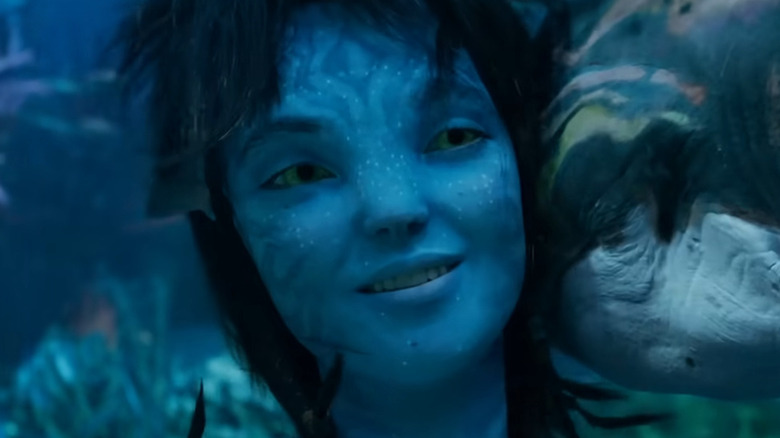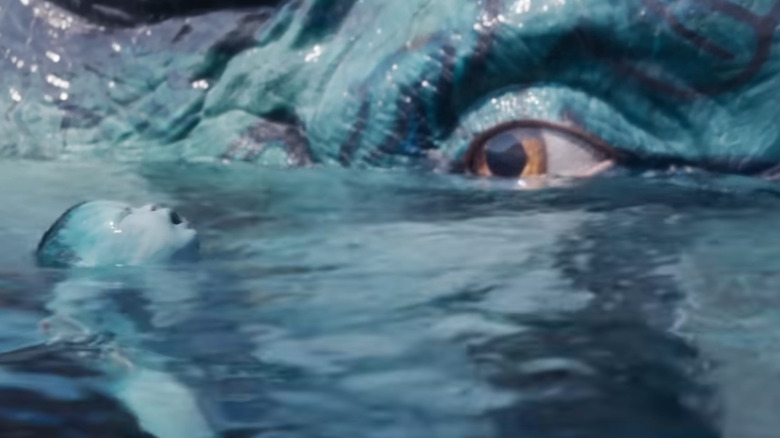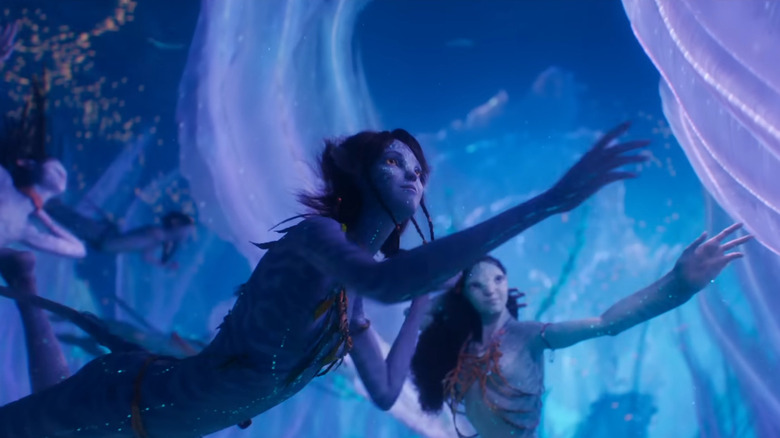Na'vi Bonding Gets More Complicated In Avatar: The Way Of Water. Here's How It Works
The following contains spoilers for "Avatar: The Way of Water."
When "Avatar" first came out in 2009, many were quick to draw comparisons between it and "Pocahontas" or "Dances With Wolves." However, the movie did manage to set itself apart in terms of its spectacular world-building. James Cameron and his team created an entire world and language filled with new animals and customs, making the movie feel truly lived-in.
The Na'vi felt like a real civilization, complete with religion based on something real in the world of Pandora. The Na'vi worship Eywa, which is based on the real neural connections that all of the fauna and flora on the planet remain connected to. The Na'vi can tap into this Eywa via Tsaheylu, which requires them to connect their ponytails with other materials to allow them to feel and communicate with the other plant or animal is feeling.
Tsaheylu was on full display in the first "Avatar," allowing the Na'vi and those inhabiting avatars to control animals to ride into battle or travel across large swaths of land. However, there's much more to learn about this ability, and "Avatar: The Way of Water" reveals more ways the Na'vi can bond with those around them.
Na'vi can see memories from the bonded companion
Bonding is on full display in "Avatar: The Way of Water," as Jake Sully (Sam Worthington) and Neytiri (Zoe Saldaña) ride mountain banshees to get around. Once the two take their family to the Metkayina clan, they learn how to bond with ilus and skimwings, which basically function as their forest-based counterparts, allowing the Na'vi to travel with relative ease (once they get the hang of it). However, the main animal on display in "The Way of Water" is the tulkun, which is a giant whale-like creature, but it has a very unique way of bonding.
Instead of attaching to an outer-exposed mechanism, the Na'vi must enter the tulkun's mouth. Only there will they find the neural point, as we see with Lo'ak (Britain Dalton) and Payakan. However, Lo'ak doesn't use this connection to control Payakan. Instead, he sees with Payakan saw on one fateful day, which just so happens to be the reason why the Metkayina and other tulkuns want nothing to do with him. They view him as a killer, which goes against the tulkun way.
Up until this point, we hadn't seen that bonding could lead to such a phenomenon. Lo'ak actually watches Payakan's memories, allowing greater depth and understanding within their bond.
Kiri has her own clandestine experience bonding
Kiri (Sigourney Weaver) has her own unique experience with bonding but with almost tragic consequences. Some kids from the Metkayina clan take Kiri to a special place in the reef where she can bond with a unique structure. When she connects to it, she receives an image in her head of her speaking to the human form of Dr. Grace Augustine (Weaver). However, things take a dark turn when Kiri begins seizing underwater, forcing her new friends to take her to the surface for aid.
It's unclear exactly why bonding caused Kiri to have a seizure in this instance, although Dr. Norm Spellman (Joel David Moore) and Dr. Max Patel (Dileep Rao) insist that it was a form of epilepsy with the bonding acting as a kind of trigger. Sigourney Weaver did say in an interview with Screen Rant that Kiri was more deeply connected to nature than others around her, so it's possible that had something to do with the reaction. As she explained, "I think there is a scene where she talks about hearing Eywa's breathing. I wasn't really sure what happened to Eywa when Hometree is destroyed, but clearly she still exists in some form. Eywa is [why] Kiri can hear things that other people don't hear. I think it makes Kiri quite uncomfortable, but I think because she's so sensitive to all of nature that she would also be sensitive to Eywa."
Clearly, there's more to bonding than simply being able to ride an animal around like a pony. With plenty of sequels reportedly on deck, chances are good we'll learn more about bonding in the years to come.


